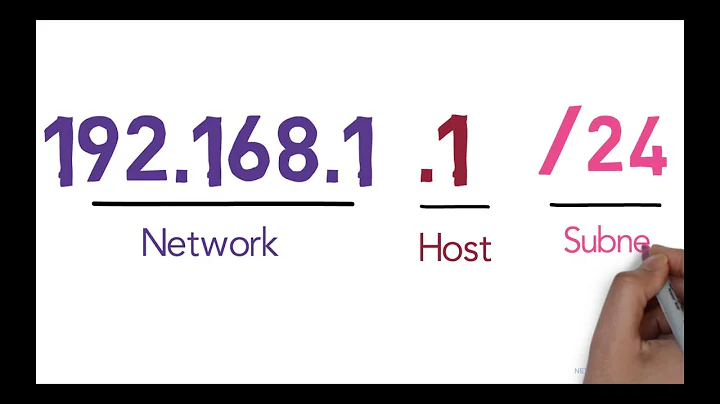Use first or last free IP for the default gateway?
Solution 1
I am of the "put the gateway at the top of the subnet" religion. It makes absolutely no difference, though.
For kicks, I've put the gateway in a /23 on the ".0" or ".255" address (i.e. 192.168.0.0/23, spanning 192.168.0.0 to 192.168.1.254, with 192.168.0.255 and 192.168.1.0 both being valid host IPs)... That's some good fun, that. I enjoy watching the heads of people who don't understand IP subnetting asplode when I tell them-- "The default gateway is 192.168.0.255..."
Solution 2
I would use 192.168.100.1, then asign IP starting at 192.168.100.10 (I keep some free IP if I need to add some network device like load balancer, etc.)
Why ? Imagine you need to shrink the network to a /25, if you have used 192.168.100.254 you must change the gateway all host.
Ok you will tell me, I can use 192.168.100.254 and start affecting IP from the top instead of the bottom then shrink to 192.168.100.128/25 instead of 192.168.100.0/24. That's right.
Now imagine you need to extend the network to 192.168.100.0/23. If a gateway set as 192.168.100.1, the gateway is still the first IP of the network when 192.168.100.254 would be in middle.
That why I prefer to take the first IP most of the time, it's also easier for others person, they just know that the gateway if the first IP in the subnet and most of the time changing the subnet will not affect this statement.
Solution 3
From what I've seen, it's almost entirely personal/organizational preference. As long as you are consistent, neither way is wrong. If you really wanted to, you could set up the router to have both IPs (but this would be silly.)
Solution 4
Less important than "is the gateway high or low?" is "did you document what you did so so in the future people will know how to find things?"
Solution 5
Usually people stick with what the device shipped with - which is very often 192.168.0.1. I work in an environment where the convention is that the gateway is .254, managed switches live on .253 downwards, backup connection on .1, servers on .2 upwards.
Related videos on Youtube
HopelessN00b
Updated on September 17, 2022Comments
-
HopelessN00b over 1 year
Please assume a simple LAN on 192.168.100.0/24. Would you configure the default router on 192.168.100.1 or 192.168.100.254 and why?
Thanks
-
Pranit Bauva almost 14 yearsFrom school I remember that the last IP should be used. But in real life I see most routers on the first IP. I wonder if there is a spec or convention for either way.
-
Antoine Benkemoun almost 14 yearsThat sounds like fun =D
-
MrGigu almost 14 yearsThat's probably because most "routers" these days are consumer-spec devices that also do DHCP, and the fewer number of characters Mrs Jones has to type (
10.1.1.1vs192.168.101.254) the less chance she'll get it wrong. -
Qwerty almost 14 years+1 for consistency
-
Qwerty almost 14 years+1 for making a good point and being Evan Anderson. =)
-
TomTom almost 14 yearsBAD argument - if you this way need to shring the network, you still need to change the network mask on all host. Ergo go to all hosts anyway -> same situation.
-
radius almost 14 yearsYes but this is a lot easier... if you change gateway on host first, you loose network on host untill you changed all host then the gateway IP (Of course you can't change gateway first or you loose your host, then can't do the change). Changing the mask doesn't imply a cut!
-
radius almost 14 years(I assume you need to go through the router to connect to hosts to do modification)
-
mpez0 almost 14 yearsI was at one lab where we had a segment where we worked on "completely legal per standard, but different from common practice" stuff to check for standards compliance. One of the head explodey things was non-contigous netmasks, like aaaaaaaa or ffff00ff.
-
Pranit Bauva almost 14 yearsOkay. That's a small but also interesting advantage for low IPs.
-
 Admin almost 14 yearsI think this is a valid answer. In the case of changing the subnet size it feels more natural to keep the low adresses and take care of the other hosts in the next step.
Admin almost 14 yearsI think this is a valid answer. In the case of changing the subnet size it feels more natural to keep the low adresses and take care of the other hosts in the next step. -
Arioch 'The almost 14 yearsI agree, consistency is important.
-
psychowood almost 14 yearsSure (I promise)
-
 Rob Moir almost 14 years@ John Gardeniers: I'd love to say that people who don't understand subnetting shouldn't be debugging a tcp/ip network... but we all know that doesn't always work
Rob Moir almost 14 years@ John Gardeniers: I'd love to say that people who don't understand subnetting shouldn't be debugging a tcp/ip network... but we all know that doesn't always work -
Spence almost 14 years@mp3z0: Didn't CIDR made non-contiguous subnet masks illegal?
-
PF4Public almost 8 years+1 for documenting




